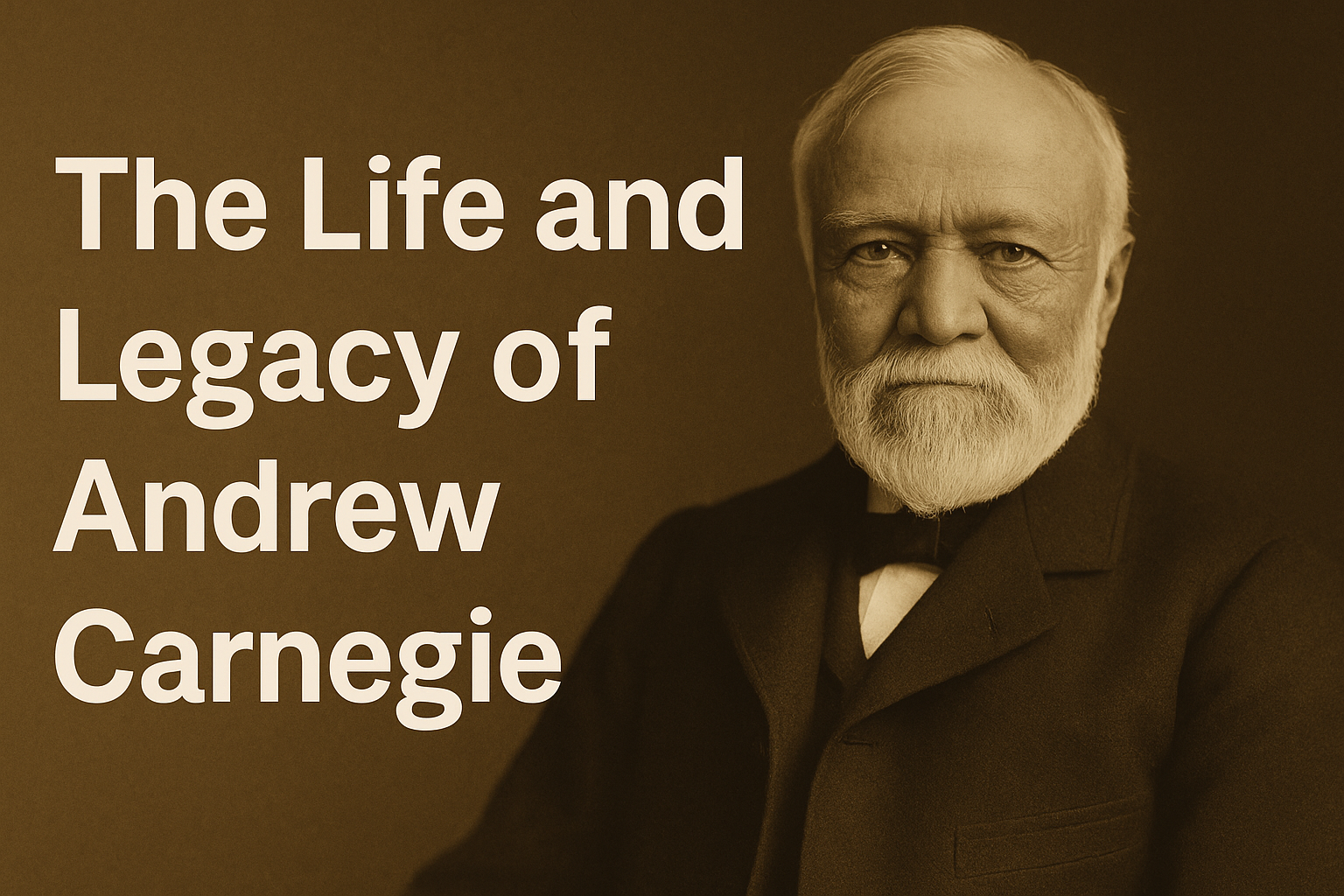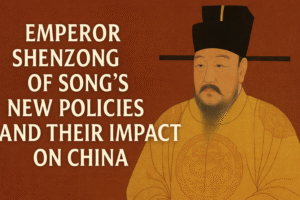Andrew Carnegie’s journey is the kind of story that defines the American Dream. Born on November 25, 1835, in Dunfermline, Scotland, Carnegie came from a working-class background. His father, William Carnegie, was a handloom weaver, and his mother, Margaret Morrison, helped support the family by repairing shoes and assisting her brother, who ran a small grocery shop.
Life in Scotland was hard, and economic hardship forced the Carnegie family to make a life-altering decision. In 1848, the Carnegies emigrated to the United States in search of better opportunities. They settled in Allegheny, Pennsylvania, where young Andrew began his working life at the age of 13.
He started off as a bobbin boy in a cotton factory, earning just $1.20 per week. Despite the grueling nature of the job, he remained optimistic and focused on self-education. Carnegie spent much of his free time reading books from a local library owned by Colonel James Anderson, who allowed working boys to borrow one book a week. This access to knowledge left a lifelong impression on Carnegie and planted the seed for his later commitment to education and public libraries.
- From Telegraph Boy To Industrial Magnate
- Building The American Steel Empire
- The Philosophy Behind Wealth And The Gospel Of Giving
- Legacy Of Libraries, Education, And Global Peace
- Controversy And The Cost Of Empire
- The Enduring Influence Of A Self-Made Titan
- Follow My Journey And Get Inspired To Transform Your Life For The Better
From Telegraph Boy To Industrial Magnate
Carnegie’s work ethic and thirst for knowledge helped him climb the ranks quickly. He secured a job as a telegraph messenger and was soon promoted to operator. His ability to learn quickly, network strategically, and recognize patterns others missed gave him a competitive edge.
By 1853, he had joined the Pennsylvania Railroad Company, where he worked under Thomas A. Scott, one of the most influential men in the railroad business. Carnegie learned a great deal from Scott and was soon promoted to superintendent of the Pittsburgh Division. More importantly, he began making smart investments. His first major win came when he invested in the Woodruff Sleeping Car Company, which introduced the idea of sleeping cars for train travel—a novelty at the time.
Carnegie’s interest in investing grew, and over time, he diversified his portfolio. He placed money in railroads, bridges, oil derricks, and iron works. One of his most significant moves was his investment in the Keystone Bridge Company, which focused on replacing wooden bridges with stronger, more durable iron ones. This experience served as the stepping stone for what would become Carnegie’s most successful venture—steel.
Building The American Steel Empire
By the 1870s, Carnegie had shifted his focus almost entirely to the steel industry. He recognized that steel, not iron, would be the material of the future. It was stronger, more versatile, and crucial to the growing demands of America’s industrial expansion.
In 1875, he opened the Edgar Thomson Steel Works in Braddock, Pennsylvania, named after the president of the Pennsylvania Railroad. This move marked the beginning of Carnegie Steel, which would eventually dominate the American steel industry. By using the Bessemer process—a revolutionary method of producing steel cheaply and efficiently—Carnegie was able to outproduce and underprice his competitors.
Carnegie was a master of vertical integration. He owned not just the steel mills but also the mines, the railroads, and even the ships that transported his goods. This control over every aspect of production allowed him to slash costs and maximize profits, giving his company an unbeatable advantage.
By the 1890s, Carnegie Steel was the largest and most profitable steel company in the world. It played a crucial role in building the infrastructure of the United States, providing the materials for railroads, bridges, skyscrapers, and ships.
The Philosophy Behind Wealth And The Gospel Of Giving
Despite his ruthless business tactics, Andrew Carnegie had a unique philosophy about wealth. In 1889, he wrote an essay titled “The Gospel of Wealth,” in which he argued that the wealthy had a moral obligation to distribute their fortunes in ways that promoted the welfare and happiness of the common man.
He believed that dying rich was disgraceful. According to Carnegie, it was the duty of the rich to use their wealth to advance society, rather than hoard it for their own pleasure or pass it down in full to their descendants. This ideology shaped the latter part of his life.
Carnegie famously wrote, “The man who dies thus rich dies disgraced.” These weren’t just words. He lived by them. After selling Carnegie Steel to J.P. Morgan in 1901 for a staggering $480 million (equivalent to over $15 billion today), he dedicated the rest of his life to philanthropy.
Morgan reorganized the assets into U.S. Steel, the first company in history to be valued at over $1 billion, while Carnegie turned his attention to a different kind of empire—one of learning, peace, and global cooperation.
Legacy Of Libraries, Education, And Global Peace
Andrew Carnegie’s philanthropic efforts were unprecedented for his time. One of his most enduring legacies is the establishment of over 2,500 public libraries across the world, known as Carnegie Libraries. These libraries made knowledge accessible to millions and reflected Carnegie’s belief that access to books was crucial for self-improvement and upward mobility.
In addition to libraries, he funded the creation of numerous educational institutions. He established the Carnegie Institute of Technology in Pittsburgh (which later merged with the Mellon Institute to become Carnegie Mellon University), the Carnegie Institution for Science in Washington D.C., and the Carnegie Foundation for the Advancement of Teaching.
Carnegie also focused on promoting world peace. He built the Peace Palace in The Hague, Netherlands, which remains a key institution in international law and conflict resolution. He also established the Carnegie Endowment for International Peace, which continues to play a role in global diplomacy.
His philanthropic reach extended to supporting scientific research, art, and music. Institutions like the Carnegie Hall in New York City stand as iconic reminders of his contributions to cultural life.
By the time of his death in 1919, Carnegie had given away approximately $350 million—over 90% of his fortune. The foundations and institutions he created continue to impact millions of lives today.
Controversy And The Cost Of Empire
While Carnegie is celebrated for his philanthropy and contributions to society, his legacy is not without controversy. His role in labor disputes, particularly the infamous Homestead Strike of 1892, has drawn significant criticism.
The Homestead Strike occurred at one of Carnegie’s steel mills in Pennsylvania. Workers, represented by the Amalgamated Association of Iron and Steel Workers, went on strike due to wage cuts. Carnegie had left his associate Henry Clay Frick in charge during the dispute. Frick hired private security from the Pinkerton Detective Agency to break the strike, leading to a violent clash that resulted in deaths on both sides.
Though Carnegie was away in Scotland during the incident, he was held morally responsible by many. Critics argue that while he preached generosity and public good, he allowed harsh working conditions and opposed unions in his businesses. His duality as both a ruthless capitalist and a generous philanthropist remains one of the most complex aspects of his legacy.
Carnegie also believed in Social Darwinism—the idea that wealth was a sign of fitness and poverty a sign of weakness. This view shaped how he gave his money; he often avoided direct charity, instead funding institutions that encouraged self-help.
The Enduring Influence Of A Self-Made Titan
Andrew Carnegie’s life reads like a parable. From a poor Scottish boy working in a cotton mill to one of the richest men in history, his story is both inspirational and instructive. He embodied the possibilities of hard work, strategic thinking, and relentless ambition. But he also believed that wealth carried responsibility—an idea that influenced generations of philanthropists after him, including Bill Gates and Warren Buffett.
His approach to philanthropy—funding institutions rather than individuals—set a blueprint that is still followed today. He didn’t just want to give money; he wanted to create systems that empowered others to rise as he had.
Carnegie’s legacy lives on in the libraries that still bear his name, the universities and research centers he founded, and the ongoing efforts of his foundations. His contradictions—between capitalism and compassion, power and principle—make him one of the most fascinating figures of the Gilded Age.
Today, in a world increasingly divided by wealth and inequality, the life and ideas of Andrew Carnegie remain as relevant as ever. His story challenges us to ask: What do we owe to society when we achieve success? And how can we use our resources—not just money, but knowledge and influence—to leave the world better than we found it?
Learn What I’m Using To Build Online Passive Income Streams By Clicking Here
I do not provide personal investment or financial advice and I am not a qualified licensed investment advisor. I am documenting my online investment and financial journey and what’s working for me. Click Here to read disclaimer.
Follow My Journey And Get Inspired To Transform Your Life For The Better
“I may earn commissions as an affiliate from sponsored links within this post”





